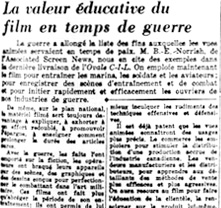Associated Screen News
-

Le Petit journal, 7 January 1945, p. 33
Source : Bibliothèque et Archives nationale du Québec
-

Photomontage of images from Rhapsody in Two Languages (1932).
Source : Cinémathèque québécoise, 1995.2419.01.PH
The Associated Screen News studio in Montreal, initially controlled by American interests, became the largest private Canadian production company following massive investment in it by the Canadian Pacific Railway (CPR), which became the principal shareholder in February 1921. For several decades the company was run by Bernard E. Norrish, former head of the Canadian Government Motion Picture Bureau.
Associated Screen News produced mostly travelogues and geographical films, which in many cases were thinly-disguised advertisements for CPR. The company also produced industrial films and a series of newsreels and documentaries for commercial movie theatres. In addition, several American producers struck prints of their films for the Canadian market in the company’s highly-regarded laboratory.
In 1926, Associated Screen News built modern new facilities in the Notre-Dame-de-Grâce neighbourhood of Montreal. In 1931, it acquired sound recording equipment. That same year, the company hired a talented director, Gordon Sparling, who made films in the Canadian Cameos series (1932-53) which often used an inventive treatment to transcend their banal subject matter. This was the case for example with Rhapsody in Two Languages, a short documentary about the city of Montreal. Associated Screen News also produced the series Kinogram Travelogues and Camera Rambles. Until the company was acquired by Du-Art in 1958, the films in these series were often the only images of themselves that Canadians could see on their movie screens.
- Themes
- 16 mm
- Native Peoples in the Cinema
- The Talkies Arrive
- Television
- French Canadians at the NFB
- Censorship
- Religious Cinema
- Settling the Land
- Film and French language
- Cinema and Religion
- 16mm Exhibition Circuits
- Quebec’s French Cousins in its Cinema
- Colour
- Film Distributors and Exhibitors
- Hollywood in Quebec
- Maria Chapdelaine
- Quebecers in Hollywood
- Radio and Cinema
- The Massey Report
- Film Magazines
- Second World War
- Organisations
- Biographies
- Juliette Béliveau
- Jean-Yves Bigras
- Léo Choquette
- Fifi D'Orsay
- René Delacroix
- J.A. DeSève
- George Ganetakos
- Pauline Garon
- Gratien Gélinas
- Nicole Germain
- John Grierson
- Paul Gury
- Richard Jarvis
- Paul L'Anglais
- Louis-Roger Lafleur
- Herménégilde Lavoie
- Ovila Légaré
- Guy Mauffette
- Joseph Morin
- Fedor Ozep
- Jean Palardy
- Vincent Paquette
- Jean-Marie Poitevin
- Maurice Proulx
- Roger Racine
- Norma Shearer
- Gordon Sparling
- Albert Tessier
To learn more
- Le p'tit frère de Grew Owl. Dir. : Gordon Sparling [Associated Screen News, 1932]
- Vocation des mains. Dir. : Ross Pitt-Taylor [Associated Screen News, Service de Ciné-Photographie, 1943]
- Wonderland of Gaspé. Dir. : Philip Pitt-Taylor [Associated Screen News, Office du tourisme de la Province de Québec, 1936]
-
Peter Morris. Embattled shadows : a history of Canadian cinema, 1895-1939 (Montréal : McGill-Queen's University Press, 1978)